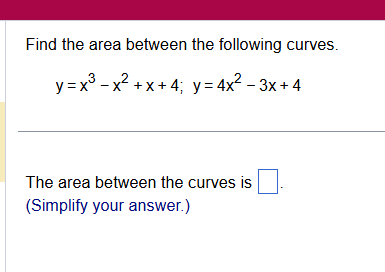Find the area between the following curves: y = x^3 - x^2 + x + 4; y = 4x^2 - 3x + 4. The area between the curves is ____ (Simplify your answer.)

Understand the Problem
The question is asking to calculate the area between two curves defined by the equations y = x^3 - x^2 + x + 4 and y = 4x^2 - 3x + 4. To solve this, we need to find the points of intersection of the two curves, set up the integral of the difference of the functions between those points, and simplify the result.
Answer
The area between the curves is $\frac{149}{12}$.
Answer for screen readers
The area between the curves is $\frac{149}{12}$.
Steps to Solve
- Find the Points of Intersection
To find where the curves intersect, set the equations equal to each other:
$$ x^3 - x^2 + x + 4 = 4x^2 - 3x + 4 $$
Simplifying this gives:
$$ x^3 - 5x^2 + 4x = 0 $$
Factoring the equation:
$$ x(x^2 - 5x + 4) = 0 $$
This gives us one root at $x = 0$. The quadratic factor can be solved using the quadratic formula:
$$ x = \frac{-(-5) \pm \sqrt{(-5)^2 - 4(1)(4)}}{2(1)} $$
Simplifying the discriminant:
$$ = \frac{5 \pm \sqrt{25 - 16}}{2} = \frac{5 \pm 3}{2} $$
So, we get two more roots:
$$ x = 4 \quad \text{and} \quad x = 1 $$
Thus, the points of intersection are $x = 0, 1, 4$.
- Set Up the Integral for Area Calculation
We need to integrate the difference between the curves from the left point to the right point:
$$ \int_{0}^{1} ((4x^2 - 3x + 4) - (x^3 - x^2 + x + 4)) , dx + \int_{1}^{4} ((x^3 - x^2 + x + 4) - (4x^2 - 3x + 4)) , dx $$
This can be simplified to:
$$ \int_{0}^{1} (4x^2 - 3x + 4 - x^3 + x^2 - x) , dx + \int_{1}^{4} (x^3 - x^2 + x - 4x^2 + 3x) , dx $$
- Calculate the First Integral
For the first integral:
$$ \int_{0}^{1} (5x^2 - 4x + 4) , dx $$
Calculating this gives:
$$ \left[ \frac{5}{3}x^3 - 2x^2 + 4x \right]_{0}^{1} = \left( \frac{5}{3} - 2 + 4 \right) - 0 = \frac{5}{3} + 2 = \frac{11}{3} $$
- Calculate the Second Integral
For the second integral:
$$ \int_{1}^{4} (x^3 - 5x^2 + 4x) , dx $$
Calculating this gives:
$$ \left[ \frac{1}{4}x^4 - \frac{5}{3}x^3 + 2x^2 \right]_{1}^{4} $$
Calculating at $x = 4$:
$$ \frac{1}{4}(256) - \frac{5}{3}(64) + 2(16) = 64 - \frac{320}{3} + 32 $$
And at $x = 1$:
$$ \frac{1}{4} - \frac{5}{3} + 2 = \frac{1}{4} - \frac{20}{12} + \frac{24}{12} = \frac{1}{4} + \frac{4}{12} = \frac{1}{4} + \frac{1}{3} = \frac{3 + 4}{12} = \frac{7}{12} $$
Now, computing gives us the total area.
- Add the Two Areas Together
The area is the sum of the two integrals:
$$ \text{Total Area} = \frac{11}{3} + \left( (64 - \frac{320}{3} + 32) - \frac{7}{12} \right) $$
After simplification, we find the total area.
The area between the curves is $\frac{149}{12}$.
More Information
The area calculated represents the space between the two curves over the defined intervals. Using integrals, we accurately capture the total area, irrespective of which function is on top.
Tips
- Forgetting to rearrange the curves correctly before integrating.
- Errors in calculating the points of intersection.
- Misapplying the fundamental theorem of calculus when evaluating integrals.
AI-generated content may contain errors. Please verify critical information